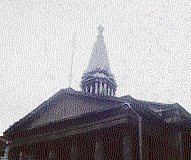Nicholas Hawksmoor

- St George’s Bloomsbury, with a stepped spire imitated from the vanished Mausoleum of Halicarnassus (one of the Seven Wonders of the World) as described by the Roman writer Pliny.
The steeple was depicted by Hogarth
[click on the picture to enlarge it]
Nicholas Hawksmoor (c.1661-1735) is one of the greatest British architects of the 18th century, even if his reputation during his lifetime, and even up to present times, has not always been equal to his genius. His relative obscurity is no doubt due to the fact that he most often worked in the shadow of two other great architects: Christopher Wren and John Vanbrugh. Moreover, the magnificent churches he built in London suffered greatly from modifications carried out in the 19th century, and even more so from Nazi bombings during the Second World War.
Originally from Nottinghamshire, Hawksmoor was employed in London from the age of 18 by Wren as assistant, draughtsman, then site supervisor. Wren secured his assistant’s appointment to the Royal Board of Works, of which he was the Secretary from 1715 to 1718, and from 1726 to his death. Hawksmoor therefore had the opportunity to closely follow a number of sites in the capital and it surroundings, including churches in the City rebuilt after the Great Fire of 1666, a naval hospital in Greenwich, Kensington Palace, or even Westminster Abbey (to which he added several pseudo-gothic towers in 1734).
From 1702, he also worked in close collaboration with Vanbrugh, who had just been appointed Surveyor of the Royal Palaces. Their joint masterpiece, built between 1705 and 1725, was Blenheim Palace (Oxfordshire), which was offered by the nation to the Duke of Marlborough in return for his military victories. Both Wren and Vanbrugh appreciated the skill and devotion of a man who never sought to put himself forward, despite his talent.
Although Hawksmoor carried out the construction of a certain number of university buildings in Oxford, like All Souls College (1716-35), as well as a small number of private residences, like Easton Neston (Northamptonshire), it is above all in the capital that he was able to give the full measure of his originality. As official architect appointed in 1711 by the Committee for the construction of 50 new churches in London, he was able to complete a series of churches which are powerfully original masterpieces, and which have caused him to be compared to Borromini: St. Alfege, Greenwich (1712-14), St Ann, Limehouse (1714-30), St. George in the East, Stepney (1714-29), Christ Church Spitalfields (1714-29), St. Mary Woolnoth (1716-24), St. George’s Bloomsbury (1716-31). The architect gave free rein to his taste for massive and sculptural volumes, and for violent contrasts of light and shadow. If he was essentially classical in details, he transcended this by the originality of his skylines and church bell towers.
Hawksmoor also consecrated a lot of time to more humble constructions, like the arsenals, forts and barracks he was asked to do by the Arsenal of Woolwich, 1717-1720. He also drew the plans for buildings intended for the poor, like the charity school at Kensington, and provided a standard plan of a workhouse, which was used in particular in the London parish of St. George, Hanover Square.

